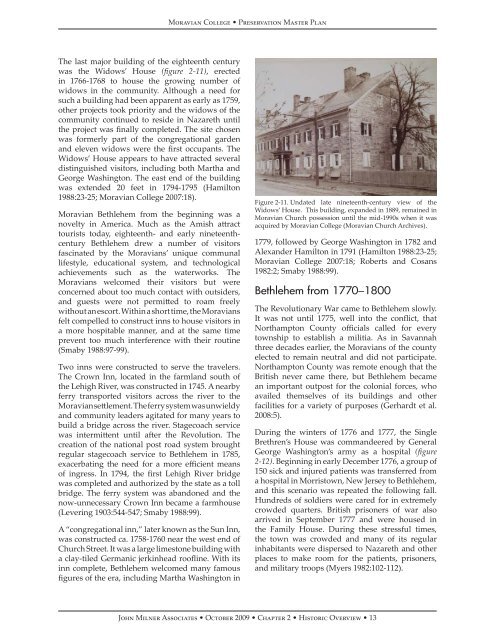Moravian Preservation Master Plan.indb - Society for College and ...
Moravian Preservation Master Plan.indb - Society for College and ...
Moravian Preservation Master Plan.indb - Society for College and ...
You also want an ePaper? Increase the reach of your titles
YUMPU automatically turns print PDFs into web optimized ePapers that Google loves.
<strong>Moravian</strong> <strong>College</strong> • <strong>Preservation</strong> <strong>Master</strong> <strong>Plan</strong><br />
The last major building of the eighteenth century<br />
was the Widows’ House (figure 2-11), erected<br />
in 1766-1768 to house the growing number of<br />
widows in the community. Although a need <strong>for</strong><br />
such a building had been apparent as early as 1759,<br />
other projects took priority <strong>and</strong> the widows of the<br />
community continued to reside in Nazareth until<br />
the project was finally completed. The site chosen<br />
was <strong>for</strong>merly part of the congregational garden<br />
<strong>and</strong> eleven widows were the first occupants. The<br />
Widows’ House appears to have attracted several<br />
distinguished visitors, including both Martha <strong>and</strong><br />
George Washington. The east end of the building<br />
was extended 20 feet in 1794-1795 (Hamilton<br />
1988:23-25; <strong>Moravian</strong> <strong>College</strong> 2007:18).<br />
<strong>Moravian</strong> Bethlehem from the beginning was a<br />
novelty in America. Much as the Amish attract<br />
tourists today, eighteenth- <strong>and</strong> early nineteenthcentury<br />
Bethlehem drew a number of visitors<br />
fascinated by the <strong>Moravian</strong>s’ unique communal<br />
lifestyle, educational system, <strong>and</strong> technological<br />
achievements such as the waterworks. The<br />
<strong>Moravian</strong>s welcomed their visitors but were<br />
concerned about too much contact with outsiders,<br />
<strong>and</strong> guests were not permitted to roam freely<br />
without an escort. Within a short time, the <strong>Moravian</strong>s<br />
felt compelled to construct inns to house visitors in<br />
a more hospitable manner, <strong>and</strong> at the same time<br />
prevent too much interference with their routine<br />
(Smaby 1988:97-99).<br />
Two inns were constructed to serve the travelers.<br />
The Crown Inn, located in the farml<strong>and</strong> south of<br />
the Lehigh River, was constructed in 1745. A nearby<br />
ferry transported visitors across the river to the<br />
<strong>Moravian</strong> settlement. The ferry system was unwieldy<br />
<strong>and</strong> community leaders agitated <strong>for</strong> many years to<br />
build a bridge across the river. Stagecoach service<br />
was intermittent until after the Revolution. The<br />
creation of the national post road system brought<br />
regular stagecoach service to Bethlehem in 1785,<br />
exacerbating the need <strong>for</strong> a more efficient means<br />
of ingress. In 1794, the first Lehigh River bridge<br />
was completed <strong>and</strong> authorized by the state as a toll<br />
bridge. The ferry system was ab<strong>and</strong>oned <strong>and</strong> the<br />
now-unnecessary Crown Inn became a farmhouse<br />
(Levering 1903:544-547; Smaby 1988:99).<br />
A “congregational inn,” later known as the Sun Inn,<br />
was constructed ca. 1758-1760 near the west end of<br />
Church Street. It was a large limestone building with<br />
a clay-tiled Germanic jerkinhead roofline. With its<br />
inn complete, Bethlehem welcomed many famous<br />
figures of the era, including Martha Washington in<br />
Figure 2-11. Undated late nineteenth-century view of the<br />
Widows’ House. This building, exp<strong>and</strong>ed in 1889, remained in<br />
<strong>Moravian</strong> Church possession until the mid-1990s when it was<br />
acquired by <strong>Moravian</strong> <strong>College</strong> (<strong>Moravian</strong> Church Archives).<br />
1779, followed by George Washington in 1782 <strong>and</strong><br />
Alex<strong>and</strong>er Hamilton in 1791 (Hamilton 1988:23-25;<br />
<strong>Moravian</strong> <strong>College</strong> 2007:18; Roberts <strong>and</strong> Cosans<br />
1982:2; Smaby 1988:99).<br />
Bethlehem from 1770–1800<br />
The Revolutionary War came to Bethlehem slowly.<br />
It was not until 1775, well into the conflict, that<br />
Northampton County officials called <strong>for</strong> every<br />
township to establish a militia. As in Savannah<br />
three decades earlier, the <strong>Moravian</strong>s of the county<br />
elected to remain neutral <strong>and</strong> did not participate.<br />
Northampton County was remote enough that the<br />
British never came there, but Bethlehem became<br />
an important outpost <strong>for</strong> the colonial <strong>for</strong>ces, who<br />
availed themselves of its buildings <strong>and</strong> other<br />
facilities <strong>for</strong> a variety of purposes (Gerhardt et al.<br />
2008:5).<br />
During the winters of 1776 <strong>and</strong> 1777, the Single<br />
Brethren’s House was comm<strong>and</strong>eered by General<br />
George Washington’s army as a hospital (figure<br />
2-12). Beginning in early December 1776, a group of<br />
150 sick <strong>and</strong> injured patients was transferred from<br />
a hospital in Morristown, New Jersey to Bethlehem,<br />
<strong>and</strong> this scenario was repeated the following fall.<br />
Hundreds of soldiers were cared <strong>for</strong> in extremely<br />
crowded quarters. British prisoners of war also<br />
arrived in September 1777 <strong>and</strong> were housed in<br />
the Family House. During these stressful times,<br />
the town was crowded <strong>and</strong> many of its regular<br />
inhabitants were dispersed to Nazareth <strong>and</strong> other<br />
places to make room <strong>for</strong> the patients, prisoners,<br />
<strong>and</strong> military troops (Myers 1982:102-112).<br />
John Milner Associates • October 2009 • Chapter 2 • Historic Overview • 13

















